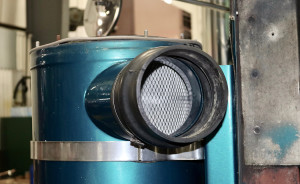 Many of us who have been in the trucking industry all our lives, and even some younger people, have a fascination for older “classic” trucks. There’s something special about rebuilt old iron – especially a Class 8 truck from the mid 1970’s and older. This article will be about a commonly overlooked problem, among other things, when installing a newer diesel engine into an older truck – air flow.
Many of us who have been in the trucking industry all our lives, and even some younger people, have a fascination for older “classic” trucks. There’s something special about rebuilt old iron – especially a Class 8 truck from the mid 1970’s and older. This article will be about a commonly overlooked problem, among other things, when installing a newer diesel engine into an older truck – air flow.
The older and smaller cubic inch engines did not require a lot of fresh air to run properly, which is measured in CFM (cubic feet of air per minute). The Small Cam Cummins engines that were 335-hp and lower only required about 850 CFM. The older J Series Cummins, 237 Mack, and the 671/8V71 Detroits all required less than 800 CFM. We all know the dual Vortox polished stainless-steel air filters on the newer Kenworths, Peterbilts, Western Stars and Freightliner Classics are beautiful, but they also perform a necessary function – increased air flow for today’s bigger engines.
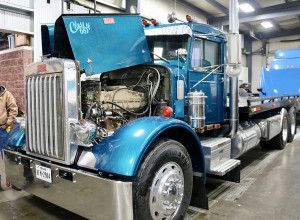 The 15-inch diameter Vortox filters provide 1,700 CFM each, giving the engine 3,400 CFM of air. A 600-hp 14, 15 or 16-liter diesel engine requires 1,600 CFM. Many of you now have 750 horses under your right foot, and that will require a whopping 1,987 CFM. One air filter under the hood of the aero trucks of today will not supply that amount of air. Fortunately, those of you who have that kind of power are wise enough not to pull a mountain with your foot on the floor.
The 15-inch diameter Vortox filters provide 1,700 CFM each, giving the engine 3,400 CFM of air. A 600-hp 14, 15 or 16-liter diesel engine requires 1,600 CFM. Many of you now have 750 horses under your right foot, and that will require a whopping 1,987 CFM. One air filter under the hood of the aero trucks of today will not supply that amount of air. Fortunately, those of you who have that kind of power are wise enough not to pull a mountain with your foot on the floor.
With all this in mind, we currently have a 1968 Peterbilt in our shop that has been re-powered with a 14-liter Big Cam 3 Cummins with 350 horsepower. This truck is based in Texas and is owned by a crop duster who works out of town most of the time. His wife drives the motor home in which they live, and he drives the ‘68 Pete, which pulls a stacker trailer with their vehicles and rock crawler Jeeps. He was not able to find a good Big Cam Cummins mechanic in Texas to help him with his problem, which was the engine always fell flat, regardless of how much fuel they gave it, so he called us. But, as you know, there is more to performance than just adding fuel.
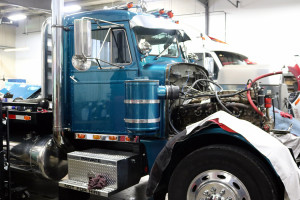 After several phone conversations, I had him bring the ‘68 Pete to our shop in Saxonburg, PA. After a few hours of working on the engine, we uncovered several problems. The engine was supposed to be built to 400 horsepower, but it had 350-hp pistons, which we can work with. Next, the timing was set for a 400, which is good, and it had 400 injectors, which is also good, but the fuel pump was a mess – it had been rebuilt twice before an older Cummins guy made changes to it without a calibration stand to test it (sometimes you can get away with this if everything is tuned for the same level of performance). The next problem was the turbo, which was too small. We also found worn main and rod bearings, several oil leaks, and the rear engine mounts literally fell into our hands as we attempted to work on them.
After several phone conversations, I had him bring the ‘68 Pete to our shop in Saxonburg, PA. After a few hours of working on the engine, we uncovered several problems. The engine was supposed to be built to 400 horsepower, but it had 350-hp pistons, which we can work with. Next, the timing was set for a 400, which is good, and it had 400 injectors, which is also good, but the fuel pump was a mess – it had been rebuilt twice before an older Cummins guy made changes to it without a calibration stand to test it (sometimes you can get away with this if everything is tuned for the same level of performance). The next problem was the turbo, which was too small. We also found worn main and rod bearings, several oil leaks, and the rear engine mounts literally fell into our hands as we attempted to work on them.
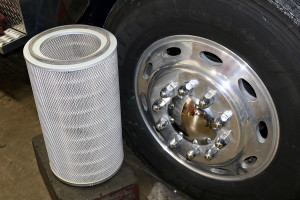 As I was standing there looking at this ‘68 Pete, I thought of a good friend of mine named Paul Lambert that is retired from trucking now and lives in West Virginia. Paul was a great mechanic and owner operator. He owned a skinny windshield 1971 Peterbilt which was powered by an NTC 335 Cummins. Before I met Paul, he installed a Big Cam 400 into his Peterbilt but there was no turbo boost gauge or pyrometer (exhaust gas temperature gauge) in the instrument panel. If you’ve read my articles before, you know how essential these gauges are on any turbocharged vehicle.
As I was standing there looking at this ‘68 Pete, I thought of a good friend of mine named Paul Lambert that is retired from trucking now and lives in West Virginia. Paul was a great mechanic and owner operator. He owned a skinny windshield 1971 Peterbilt which was powered by an NTC 335 Cummins. Before I met Paul, he installed a Big Cam 400 into his Peterbilt but there was no turbo boost gauge or pyrometer (exhaust gas temperature gauge) in the instrument panel. If you’ve read my articles before, you know how essential these gauges are on any turbocharged vehicle.
After Paul installed the gauges, we realized his problem was a lack of air. The exhaust manifold was flaking from too much heat. Driving without a turbo boost gauge and pyrometer is like driving blind. You do NOT know what is going on in your engine. I was working with Paul at his home and standing next to the ‘71 Pete’s single air cleaner housing and it occurred to me that this system was built for a 335-hp engine, which requires 300 CFM less air than the 400-hp engine.
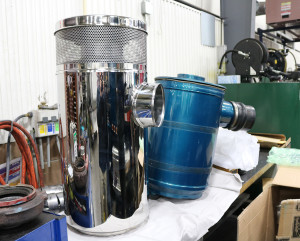 I took the measurements of the inlet and outlet, wrote down the part number of the air filter, and then called Donaldson, who confirmed my suspicions – the air filter housing was too small. I ordered Paul the largest air filter housing Donaldson had, which was 1,600 CFM. He installed it and called me the next day. His statement was, “My truck finally runs free. I can go down the highway without having to push hard on the throttle and the exhaust gas temperature is much lower.” Problem solved, and no more flaking of the exhaust manifold, either. Once we gave Paul’s engine the air it needed, it had more horsepower and got better mileage, which also increased his driving pleasure.
I took the measurements of the inlet and outlet, wrote down the part number of the air filter, and then called Donaldson, who confirmed my suspicions – the air filter housing was too small. I ordered Paul the largest air filter housing Donaldson had, which was 1,600 CFM. He installed it and called me the next day. His statement was, “My truck finally runs free. I can go down the highway without having to push hard on the throttle and the exhaust gas temperature is much lower.” Problem solved, and no more flaking of the exhaust manifold, either. Once we gave Paul’s engine the air it needed, it had more horsepower and got better mileage, which also increased his driving pleasure.
Back to the ‘68 Pete in the shop. Looking at the inlet and outlet of the single air filter housing, both were only 5.5 inches. I knew these engines needed at least a 7-inch inlet and outlet to supply enough air to the engine. Again, I called Donaldson and gave them the specs. I was correct – the air filter housing has 760 CFM at 6 inches, 880 CFM at 8 inches and 980 CFM at 10 inches. This is another reason why this older Pete would not cruise effortlessly along the level highways.
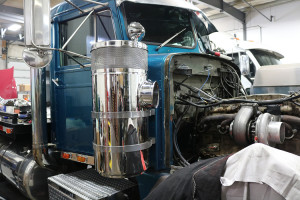 We are now installing a 1,700 CFM Vortox air filter housing on this classic truck, along with a bunch of other work, and should have it finished in the next few days. Then, it will go on the dyno and be test driven. I will have the results for you in the next article, so stay tuned! If you have any comments or questions, I can be reached at Pittsburgh Power in Saxonburg, PA at (724) 360-4080. To see all the available products and services we offer to improve the performance and efficiency of your ride, visit us at www.pittsburghpower.com today.
We are now installing a 1,700 CFM Vortox air filter housing on this classic truck, along with a bunch of other work, and should have it finished in the next few days. Then, it will go on the dyno and be test driven. I will have the results for you in the next article, so stay tuned! If you have any comments or questions, I can be reached at Pittsburgh Power in Saxonburg, PA at (724) 360-4080. To see all the available products and services we offer to improve the performance and efficiency of your ride, visit us at www.pittsburghpower.com today.
